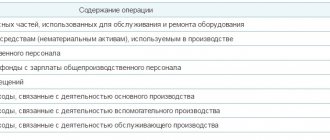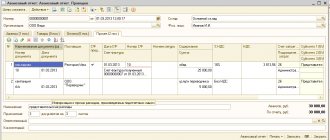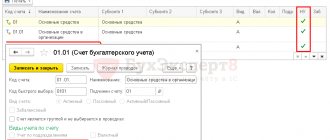General principles of cost recognition
Recognition of expenses in tax accounting is impossible without meeting two key requirements. First, all expenses must be documented. That is, for each expense transaction or group of such transactions there is a primary or accounting document, which contains all the required details and facts for the transaction.
The second condition is that any type of expenditure accepted for accounting must be economically justified. That is, it is impossible to recognize specific transactions in tax accounting if they are inexpedient, carried out without any economic justification, are not related to the types of activities being carried out, and so on.
Consequently, not all types of expenses can be reflected in tax accounting to reduce the amount of the budget payment for corporate income tax. Thus, officials in the Tax Code of the Russian Federation have determined an exhaustive list of such costs.
Article 272. Procedure for recognizing expenses using the accrual method
. Expenses accepted for tax purposes taking into account the provisions of this chapter are recognized as such in the reporting (tax) period to which they relate, regardless of the time of actual payment of funds and (or) other form of payment, unless otherwise provided in paragraph 1.1 of this articles, and are determined taking into account the provisions of Articles 318 - 320 of this Code.
Expenses are recognized in the reporting (tax) period in which these expenses arise based on the terms of the transactions. If the transaction does not contain such conditions and the relationship between income and expenses cannot be clearly defined or is determined indirectly, the expenses are distributed by the taxpayer independently.
If the terms of the agreement provide for the receipt of income over more than one reporting period and do not provide for the stage-by-stage delivery of goods (work, services), expenses are distributed by the taxpayer independently, taking into account the principle of uniform recognition of income and expenses.
The taxpayer's expenses, which cannot be directly attributed to the costs of a specific type of activity, are distributed in proportion to the share of the corresponding income in the total volume of all income of the taxpayer.
1.1. The taxpayer recognizes expenses from carrying out activities related to the production of hydrocarbons at a new offshore hydrocarbon field in the tax (reporting) period to which they relate, regardless of the time of actual payment of funds and (or) other form of payment, but not earlier than the date of allocation of a new offshore hydrocarbon deposit on a subsoil plot or in the cases provided for in paragraph 8 of Article 261 of this Code, the date of the taxpayer’s decision to complete work on the development of natural resources or part thereof on a specified subsoil plot or to completely stop work on a subsoil plot in due to economic inexpediency, geological futility or other reasons.
If more than one new offshore hydrocarbon deposit is allocated on a subsoil plot, the amount of expenses up to the date of allocation of new offshore hydrocarbon deposits on a subsoil plot related to activities related to the production of hydrocarbon raw materials at a new offshore hydrocarbon deposit carried out at each new offshore hydrocarbon deposit this subsoil plot is determined taking into account the provisions of paragraph 4 of Article 299.4 of this Code.
The expenses specified in this paragraph, expressed in foreign currency, for tax purposes are recalculated into rubles at the official rate established by the Central Bank of the Russian Federation on the dates corresponding to the dates of recognition of similar types of expenses in accordance with paragraphs 2 - 8.1 of this article, without taking into account the provisions of paragraph one of this paragraph, as well as the provisions of paragraphs 7 and 8 of Article 261 of this Code.
. The date of material expenses is recognized as follows:
- date of transfer of raw materials and materials into production - in terms of raw materials and materials attributable to the goods (work, services) produced;
- date of signing by the taxpayer of the certificate of acceptance and transfer of services (works) - for services (works) of a production nature.
. Depreciation is recognized as an expense on a monthly basis based on the amount of accrued depreciation, calculated in accordance with the procedure established by Articles 259, 259.1, 259.2 and 322 of this Code.
Expenses in the form of capital investments provided for in paragraph 9 of Article 258 of this Code are recognized as indirect expenses of the reporting (tax) period on which, in accordance with this chapter, the start date of depreciation (date of change in the original cost) of fixed assets in respect of which capital investments have been made.
. Labor costs are recognized as an expense on a monthly basis based on the amount of labor costs accrued in accordance with Article 255 of this Code.
. Expenses for the repair of fixed assets are recognized as an expense in the reporting period in which they were incurred, regardless of their payment, taking into account the specifics provided for in Article 260 of this Code.
5.1. Standardization expenses incurred by the taxpayer independently or jointly with other organizations (in an amount corresponding to its share of expenses) are recognized for tax purposes in the reporting (tax) period following the reporting (tax) period in which the standards were approved as national standards national body of the Russian Federation for standardization or registered as regional standards in the Federal Information Fund of Technical Regulations and Standards in the manner established by the legislation of the Russian Federation on technical regulation.
. Expenses for compulsory and voluntary insurance (non-state pension provision) are recognized as an expense in the reporting (tax) period in which, in accordance with the terms of the agreement, the taxpayer transferred (issued from the cash register) funds to pay insurance (pension) contributions. If the terms of an insurance contract (non-state pension provision) provide for the payment of an insurance (pension) contribution in a one-time payment, then under contracts concluded for more than one reporting period, expenses are recognized evenly over the term of the contract in proportion to the number of calendar days of the contract in the reporting period. If the terms of the insurance contract (non-state pension provision) provide for payment of the insurance premium (pension contribution) in installments, then under contracts concluded for more than one reporting period, expenses for each payment are recognized evenly over the period corresponding to the period for payment of contributions (year, half-year, quarter, month), in proportion to the number of calendar days of the agreement in the reporting period.
. The date of non-operating and other expenses is recognized, unless otherwise established by Articles 261, 262, 266 and 267 of this Code:
- 1) date of accrual of taxes (fees, insurance premiums) - for expenses in the form of amounts of taxes (advance payments for taxes), fees, insurance premiums and other obligatory payments;
- 2) the date of accrual in accordance with the requirements of this chapter - for expenses in the form of amounts of contributions to reserves recognized as expenses in accordance with this chapter;
- 3) the date of settlements in accordance with the terms of concluded agreements or the date of presentation to the taxpayer of documents serving as the basis for making settlements, or the last date of the reporting (tax) period - for expenses:
- in the form of commission fees;
- in the form of expenses for payment to third parties for work performed (services provided);
- in the form of rental (leasing) payments for rented (leased) property;
- in the form of other similar expenses;
- in the form of amounts of paid allowances;
- in the form of compensation for the use of personal cars and motorcycles for business trips;
- in the form of interest accrued on the amount of claims of the bankruptcy creditor in accordance with the legislation on insolvency (bankruptcy);
- on business trips;
- for the maintenance of official transport;
- for entertainment expenses;
- for other similar expenses;
 the date of recognition by the debtor or the date of entry into legal force of the court decision - for expenses in the form of amounts of fines, penalties and (or) other sanctions for violation of contractual or debt obligations, as well as in the form of amounts of compensation for losses (damage);
the date of recognition by the debtor or the date of entry into legal force of the court decision - for expenses in the form of amounts of fines, penalties and (or) other sanctions for violation of contractual or debt obligations, as well as in the form of amounts of compensation for losses (damage);. Under loan agreements or other similar agreements (including debt obligations issued by securities), the validity of which falls on more than one reporting (tax) period, for the purposes of this chapter, the expense is recognized as incurred and is included in the relevant expenses at the end of each month of the corresponding reporting month. (tax) period, regardless of the date (terms) of such payments provided for by the agreement, with the exception of the expenses specified in subparagraph 12 of paragraph 7 of this article.
If a loan agreement or other similar agreement (including debt obligations issued by securities) stipulates that the fulfillment of an obligation under such an agreement depends on the value (or other value) of the underlying asset with the accrual of a fixed interest rate during the validity period of the agreement, expenses accrued based on this fixed rate, are recognized on the last day of each month of the corresponding reporting (tax) period, and expenses actually incurred based on the current value (or other value) of the underlying asset are recognized on the date of fulfillment of the obligation under this agreement.
In the event of termination of the agreement (repayment of the debt obligation) during a calendar month, the expense is recognized as incurred and is included in the corresponding expenses on the date of termination of the agreement (repayment of the debt obligation).
The provisions of this paragraph do not apply to expenses in the form of interest accrued on the amount of claims of the bankruptcy creditor in accordance with the legislation on insolvency (bankruptcy).
8.1. Expenses for the acquisition of leased property specified in subparagraph 10 of paragraph 1 of Article 264 of this Code are recognized as an expense in those reporting (tax) periods in which, in accordance with the terms of the agreement, rental (leasing) payments are provided. In this case, these expenses are taken into account in an amount proportional to the amount of rental (leasing) payments.
. Lost power. — Federal Law of April 20, 2014 N 81-FZ.
. Expenses expressed in foreign currency are recalculated for tax purposes into rubles at the official rate established by the Central Bank of the Russian Federation on the date of recognition of the relevant expense, unless otherwise established by this paragraph.
Claims (obligations), the value of which is expressed in foreign currency, property in the form of currency values are converted into rubles at the official rate established by the Central Bank of the Russian Federation on the date of transfer of ownership of the specified property, termination (fulfillment) of claims (obligations) and (or) on the last day of the current month, depending on what happened earlier.
If, when recalculating the value of claims (obligations) expressed in foreign currency (conventional monetary units) payable in rubles, a different foreign exchange rate is applied, established by law or by agreement of the parties, the recalculation of expenses, claims (obligations) in accordance with this paragraph is carried out according to this course.
In the case of transfer of an advance or deposit, expenses expressed in foreign currency are converted into rubles at the official rate established by the Central Bank of the Russian Federation on the date of transfer of the advance or deposit (in the part attributable to the advance or deposit).
Claims, the value of which is expressed in foreign currency, under a loan agreement to finance a foreign geological exploration project (including arrears on accrued interest) are converted into rubles at the official rate established by the Central Bank of the Russian Federation on the date of the decision on the foreign geological exploration project, determined in the manner established by paragraph 6 of Article 271 of this Code.
Expenses in the form of negative exchange rate differences arising as a result of recalculation of claims under a loan agreement to finance a foreign geological exploration project on the date of the decision on the foreign geological exploration project are recognized as part of non-operating expenses in one of the following ways:
- in the event of termination of obligations under a loan agreement to finance a foreign geological exploration project in full without satisfying the property claims of the taxpayer in connection with the completion of work on the specified foreign geological exploration project and recognition of such a project as economically inexpedient and (or) geologically unpromising, they are not taken into account for the purposes of taxation;
- in the event that a loan agreement for financing a foreign geological exploration project does not comply with any of the conditions specified in paragraph 11 of Article 261 of this Code, they are taken into account in full on the date when such a condition was violated;
- in other cases, they are taken into account evenly over two years, starting from the month following the month in which the decision was made on a foreign geological exploration project.
Starting from the day following the date of the decision on a foreign geological exploration project, the recalculation of claims, the value of which is expressed in foreign currency, under the corresponding loan agreement for financing a foreign geological exploration project into rubles is carried out in the general manner established by paragraphs one through four of this point.
Key cost grouping
All types of costs that an economic entity incurs in the course of its activities can be divided into two large groups. The first group should include all expenses that are associated with sales or production. That is, these are costs that are aimed at carrying out the main activity.
The second group is costs that are not directly related to sales or production. They are most often called non-operating transactions.
However, the provisions of the Tax Code of the Russian Federation provide for additional fragmentation of expenses of the first group. Thus, all costs associated with sales and production are divided into direct and indirect expenses.
For clarity, let’s define in a block diagram what the current classification of expenses in tax accounting looks like:
Now let's look at each of the groups in more detail.
Procedure for accounting for expenses for income tax purposes
Date of publication: 03/02/2016 12:53 (archive)
Article 272 of the Tax Code of the Russian Federation establishes the procedure for recognizing expenses using the accrual method.
Expenses accepted for tax purposes are recognized as such in the reporting (tax) period to which they relate, regardless of the time of actual payment of funds and (or) other form of payment and are determined taking into account the provisions of Articles 318 - 320 of the Code.
In accordance with Article 252 of the Tax Code of the Russian Federation, expenses are recognized as justified and documented expenses, and in cases provided for in Article 265 of the Tax Code of the Russian Federation, losses incurred (incurred) by the taxpayer.
Documented expenses mean expenses confirmed by documents drawn up in accordance with the legislation of the Russian Federation, or documents drawn up in accordance with business customs applied in the foreign state in whose territory the corresponding expenses were made, and (or) documents indirectly confirming expenses incurred, including a customs declaration, a business trip order, travel documents, a report on work performed in accordance with the contract. Any expenses are recognized as expenses, provided that they are incurred to carry out activities aimed at generating income.
Article 11 of the Tax Code of the Russian Federation establishes that the institutions, concepts of civil, family and other branches of legislation of the Federation used in the Code are applied in the meaning in which they are used in these branches of legislation, unless otherwise provided by the Code.
In accordance with Article 9 of the Federal Law of December 6, 2011 No. 402-FZ “On Accounting,” each fact of economic life is subject to registration as a primary accounting document. The primary accounting document must be drawn up when a fact of economic life is committed, and if this is not possible, immediately after its completion.
Thus, accounting legislation allows you to generate a document confirming expenses incurred after the reporting date, but immediately after the end of the provision of services for the month.
Article 289 of the Tax Code of the Russian Federation establishes that taxpayers, regardless of whether they have an obligation to pay tax and (or) advance payments for tax, the specifics of calculation and payment of tax, are required to submit at the end of each reporting and tax period to the tax authorities at their location and the location of each separate division of the relevant tax returns.
Thus, if the primary accounting document confirming the provision of ongoing services for the past month was drawn up immediately after the end of the month in which the fact of economic life was committed, within a reasonable period, but before the date of submission of the declaration (before the 28th day), then such primary documents confirming expenses incurred should be taken into account in the reporting period to which they relate, which should be indicated in the document.
Production and sales costs
This type of costs is characterized by the fact that the organization incurs them to ensure its own activities. Such operations are inextricably linked with conducting business in the main areas. The company carries out these expenses on a voluntary basis, that is, it independently and voluntarily bears the costs in order to ensure the viability of the company and make a profit.
Production costs are defined by a list in Article 253 of the Tax Code of the Russian Federation; a detailed description of expenditure transactions is presented in Art. 254 - 264 Tax Code of the Russian Federation. Thus, the main types of costs in this category include expenses for:
- Remuneration of key personnel (official salaries, rates, allowances, additional payments, bonuses and other payments).
- Insurance premiums accrued for the remuneration of key personnel within the framework of current legislation (Chapter 34 of the Tax Code of the Russian Federation, Law No. 125-FZ).
- Material expenses (in tax accounting these are expenses for the purchase of raw materials, materials, equipment, fuels and lubricants for production).
- Depreciation charges (amounts of accrued depreciation on fixed assets used in production).
It is worth noting that this list ends with the item “other costs,” which means that the list enshrined in the Tax Code of the Russian Federation is not closed. Consequently, tax accounting for other expenses allows the company to reflect any expense transaction as part of production expenses, provided that the company can justify it.
What expenses can be included in calculating the tax base for income tax?
The company's expenses taken into account when calculating income tax are divided into two groups: those associated with production and sales and non-operating expenses.
When calculating income tax, economically justified and documented costs can be included in the expenses taken into account when calculating the tax base. This can be done provided that they were produced to perform activities that are aimed at generating income (clause 1 of Article 252 of the Tax Code of the Russian Federation). If any of the above conditions are not met, then such costs cannot be taken into account when calculating tax.
It is clear that, like income, the company’s expenses must be taken into account in monetary form (clause 3 of Article 274 of the Tax Code of the Russian Federation).
It will not be possible to take into account expenses that are directly named in Article 270 of the Tax Code of the Russian Federation “Expenses not taken into account for tax purposes.” In addition, the legislation establishes a list of expenses that are taken into account when calculating tax within the established norms. For example, such expenses include advertising and entertainment expenses (clause 16 of article 255, article 264 of the Tax Code of the Russian Federation).
The company's expenses taken into account when calculating income tax are divided into two groups (clause 2 of Article 252 of the Tax Code of the Russian Federation):
- Costs associated with production and sales (clause 1 of Article 253 of the Tax Code of the Russian Federation). In particular, these include:
- expenses associated with the production, storage and delivery of goods, performance of work, provision of services, purchase and sale of goods;
- expenses for maintenance and operation, repair and maintenance of fixed assets and other property;
- expenses for the development of natural resources;
- R&D expenses;
- insurance costs (compulsory and voluntary);
- other expenses.
- Non-operating expenses.
Company expenses can be recognized in one of two ways provided by law (Articles 272, 273 of the Tax Code of the Russian Federation):
- accrual method;
- cash method.
Let us recall that if an organization uses the accrual method, then income should be included in the calculation of the tax base in the period in which they arise, and expenses - in the period to which they relate.
If the company uses the cash method, then income should be recognized in the period in which they are received, and expenses in the period in which they are paid. That is, expenses under the cash method must be recognized on the day of payment of money from the cash register, debit from the current account or disposal of property (clause 3 of Article 273 of the Tax Code of the Russian Federation).
In practice, it happens that a company's expenses are expressed in foreign currency. Such expenses must be converted into rubles at the Central Bank exchange rate on the date of their recognition in tax accounting. The organization's expenses, expressed in monetary units, must be recalculated at the rate established by the agreement (clause 5 of Article 252 of the Tax Code of the Russian Federation).
Take advantage of all the possibilities of Kontur.Externa
Send a request
Direct costs and indirect
This grouping of costs is provided for income tax payers who determine income and expenses on an accrual basis. Let us recall that those entities that have the right to keep records of income and expenses using the cash method should not allocate indirect costs.
If it is necessary to split production costs, the procedure for classifying an operation as a specific type must be determined by the taxpayer independently. That is, the company itself decides what type of expense a particular payment should be classified as. Such a decision to divide expenses into direct and indirect must be enshrined in the accounting policy.
So, direct costs should be attributed to the sale of goods, works, and services within the framework of production in which they were directly involved. These include material costs, wage costs and insurance premiums for key personnel. If an enterprise uses fixed assets in the production (sales) process, then accrued depreciation on these objects can also be taken into account as part of direct costs.
All other types of expense transactions, except non-operating ones, should be classified as indirect. Let us remind you that indirect expenses are recognized when forming the tax base for income tax upon the fact of occurrence, provided there are supporting primary documents.
What refers to the income and expenses of an enterprise in accounting
Every commercial company is created for the purpose of making a profit. To derive a financial result, it is necessary to competently organize the correct accounting of the organization’s income and expenses .
The results of the company’s work are of interest not only to its participants, but also to investors, as well as fiscal authorities. At the same time, tax accounting and accounting of income and expenses are somewhat different.
In accounting, the concept and algorithm for accounting for income and expenses are regulated by PBU 9/99 and PBU 10/99, respectively. At the same time, the lists of other income and expenses are open.
The company’s income is an increase in the economic benefits of the organization as a result of the receipt of cash or other assets, as well as the repayment of obligations, resulting in a capital gain (clause 2 of PBU 9/99). There are two types of income: from ordinary activities and others. What applies to each of them can be seen in the table:
| Income | |
| From ordinary activities (clause 5 of PBU 9/99) | Other (clause 7 of PBU 9/99) |
| Revenue from sales of inventory items and services | Proceeds from the sale of OS |
| Other income that is the subject of the main activity of the company | Penalties, penalties and penalties for non-compliance with contractual obligations |
| Assets received as a gift | |
| Income from the lease of company assets | |
| Exchange differences | |
| Overdue creditor | |
| Other income | |
Revenue is shown in accounting if the following conditions are met (clause 12 of PBU 9/99):
- The company has the right to it under an agreement or on the basis of another document.
- The amount of revenue can be determined.
- Ownership of the asset has passed from the seller (performer) to the buyer (customer).
- There is confidence that the company will benefit.
- The costs associated with the operation can be determined.
If the above conditions are not met, a creditor is created in accounting.
The company's expenses are a decrease in the economic benefits of the company resulting from the disposal of cash or other assets of the enterprise, as well as the formation of liabilities that led to a decrease in capital (clause 2 of PBU 10/99).
In accounting, a company's costs are also divided into 2 types: other and from ordinary activities.
| Expenses | |
| From ordinary activities (clause 5 of PBU 10/99) | Other (clause 11 PBU 10/99) |
| Costs associated with production and sales of products | Contributions to valuation reserves |
| Expenses for buying and selling goods | Expenses associated with the disposal of fixed assets |
| Costs associated with the work | Interest transferred by the company under loan agreements |
| Other expenses that are the subject of the company’s activities | Costs associated with the transfer of assets for temporary use |
| Other expenses | |
Clause 16 of PBU 10/99 provides the following factors for accepting costs in accounting:
1. The reasonableness of the costs is confirmed by a certain agreement, legal regulations or business rules.
2. The amount of costs can be identified.
3. The presence of confidence that as a result of this business operation there will be a decrease in the economic benefits of the company.
If at least one of the above conditions is not met, a receivable is recognized in accounting.
There are 2 methods of accounting for income and expenses: cash and accrual methods. The first method is used, as a rule, for simplified taxation.
Find out about the differences in the methods of accounting for income and expenses here.
IMPORTANT! The cash method in accounting can only be used by organizations that use simplified accounting methods and submit simplified accounting reports.
Find out about the nuances of accounting for income and expenses using the cash method in accounting in ConsultantPlus. If you don't have access to the system, get a free trial online.
Non-operating costs
Tax accounting of non-operating expenses - features and principles of application are enshrined in Article 265 of the Tax Code of the Russian Federation. This type of operation is not directly related to the implementation of the main activities, production and sales.
Costs of this type include:
- bank commissions;
- exchange rate differences (negative);
- interest on loans and borrowings;
- historical losses identified this year;
- other similar operations.
Standardized costs
Standardized expenses in tax accounting - such expenses are not included in the current classification, but they also occur. Thus, expenses in this category include those transactions that can be combined according to a general principle: standards have been approved for their recognition in tax accounting. In other words, costs can only be taken into account in a certain amount, but not more than the regulatory limit.
For example, entertainment expenses can be taken into account in the amount of 4% of labor costs for the same period. The costs of voluntary personnel insurance are no more than 12% of labor costs. Some advertising costs are up to 1% of sales revenue.
Legal documents
- Tax Code of the Russian Federation
- Article 253 of the Tax Code of the Russian Federation
- 254
- 264 Tax Code of the Russian Federation
- Ch. 34 Tax Code of the Russian Federation
- Law No. 125-FZ
- Tax Code of the Russian Federation
- Article 265 of the Tax Code of the Russian Federation
Costs, expenses, expenses
There are such categories in economics as costs, expenses, enterprise costs . For many decades, economists, accountants, statisticians, and tax specialists have been arguing about the specific meaning of each of them, the differences between them and their identity.
Picture 1.
Definition 1
Costs are an assessment of the value in monetary terms of material, labor, financial, information, natural and other types of resources for the production and sale of products for a specified period of time. Costs are characterized by:
- monetary valuation of resources, that is, to provide the principle of measuring resources;
- target setting, that is, they must be related to the production and sale of products as a whole or to a stage of this process;
- a certain period of time, that is, costs must be attributed to products for a given period of time.
Note 1
It should be noted that if costs are not involved in the production process and are not written off or partially written off to manufactured products, then the costs turn into inventories of raw materials, work in progress inventories, finished goods inventories and others. Thus, costs are inherent in inventory intensity and they belong to the assets of the enterprise.
Too lazy to read?
Ask a question to the experts and get an answer within 15 minutes!
Ask a Question
The concept of “expenses” is defined in PBU and the Tax Code of the Russian Federation. According to PBU, expenses of an enterprise are recognized as a decrease in economic benefits associated with the disposal of assets, in particular cash or other property, and the occurrence of liabilities that lead to a decrease in the capital of the enterprise. There are certain conditions for the ability to recognize expenses in accounting and profit and loss statements.
According to the Tax Code of the Russian Federation, expenses are justified and documented expenses incurred by taxpayers. Justified expenses are considered to be economically feasible expenses, valued in monetary terms. Documented expenses are expenses that are confirmed by documents drawn up in accordance with the requirements of Russian legislation. Expenses include any expenses incurred to carry out business activities aimed at generating income. The classification of expenses for tax and accounting purposes varies significantly.
Too lazy to read?
Ask a question to the experts and get an answer within 15 minutes!
Ask a Question
Definition 2
Thus, expenses are costs of a certain period of time, documented, economically justified and transferred their value completely to the products sold during the specified period. Expenses, unlike expenses, cannot be in a state of inventory capacity and do not belong to the assets of the enterprise. Expenses are reflected when calculating a company's profit on the income statement. “Costs” are broader than the concept of “expenses,” but under certain conditions these concepts can coincide.
The concept of “costs” is used in economic theory and practice as the concept of “costs” in terms of production of products, works or services. Some sources consider the concepts of “production costs” and “production costs” to be equivalent, but this is not entirely true. The concept of “costs” is broader than the definition of “costs”. Costs are a combination of various costs for the production and sale of products. Production costs include the costs of material, financial, labor and other types of resources for the production and sale of manufactured products. Costs also include special types of expenses: social contributions, warranty repairs, losses from defects, etc. The concepts of “production costs” and “production costs” can coincide and be considered identical only under certain conditions.
Figure 2.
Definition 3
In the methodological recommendations for accounting of costs in production and costing, the following definition of costs is given: “ Costs are the totality of all costs of economic resources in monetary form in the process of circulation of economic assets.”
The same document defines the classification of costs:
- production costs, including the value expression of resources consumed in production;
- distribution costs associated with the acquisition of material and production resources and the sale of finished products;
- economic costs, including calculated and opportunity costs;
- opportunity costs, which are lost profits from alternative uses of the organization's working capital.
- accounting costs - costs in monetary terms for the use of production factors, as a result of the use of which the process of production and sale of products is implemented.
In accounting, according to PBU, the organization’s expenses are divided as follows:
- expenses for ordinary activities;
- other expenses, including operating, non-operating and extraordinary expenses.
When generating expenses for ordinary activities, their grouping by elements is ensured, which is uniform and mandatory for all companies:
- material costs;
- labor costs;
- social Security contributions;
- depreciation;
- other costs.
The composition of expenses that are taken into account in taxation differs from the expenses recognized in accounting. In tax accounting, all expenses are divided into the following categories:
- expenses associated with the production and sale of products:
- material costs,
- the amount of accrued depreciation,
- other expenses;
labor costs,
The Tax Code of the Russian Federation defines a list of costs related to expenses associated with the production and sale of products. Other expenses include, in particular: entertainment expenses and expenses for all types of advertising. The Tax Code of the Russian Federation provides for the allocation of not five, as in accounting, but four elements of costs. Deductions for social needs are not allocated separately in tax accounting, but are included in “Labour expenses” and “Other expenses”, depending on the accounting policy of the organization.
Too lazy to read?
Ask a question to the experts and get an answer within 15 minutes!
Ask a Question







